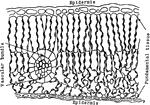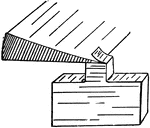
Palm Stem
"A, diagram of course of vascular bundles in a palm stem; 1m, 2m, 3m, bundles from the median portions…
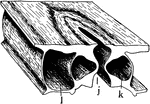
Stoma
"A typical stoma in cross section and surface view combined. k, guard cell; j, the gap or stoma between…

Stoma Guard Cells
"A, diagram showing relative position of the guard cells in cross section in the open and closed positions;…

Depressed Stoma
"A, depressed stoma of the under side of a leaf of Amherstia nobilis." -Stevens, 1916

Depressed Stoma
"B, depressed stoma of Hakea suaveolens. g stands beneath the guard cells; d, outer, and e inner, cavities."…

Stomata Formation
"B and C, early stages in the formation of stomata; at s, mother cells of guard cells are shown. D,…
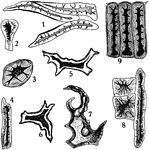
Stone Cells
"Stone cells from different sources. 1, from coffee; 2, 3, and 4, from stem of clove; 5 and 6, from…
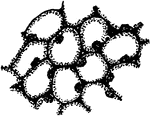
Stone Cells 1
First developmental stage of stone cells: "1, in the primary meristem condition." -Stevens, 1916
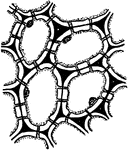
Stone Cells 2
Second developmental stage of stone cells: "2, the cells have enlarged and the walls have begun to thicken…

Stone Cells 3
Third and final developmental stage of stone cells: "3, The walls are completed. The primary wall is…

I. Balsamina Storage Tissues
"Storage tissues of the cotyledon of Impatiens Balsamina. A, from the resting seed, and B, from a germinating…

Stored Food
"Diagram to show path of stored food upward through the tracheal tubes, and through the phloem portion…

T. Majus Cell
"A, cell from the epidermis of the upper side of the calyx of Tropaeolum majus with crystalline chromoplasts."…

T. Zebrina Cell
In onion cells: "C, a cell from the epidermis of the mid-rib of Tradescantia zebrina, in its natural…

Marchantia Thallus
"Cross section through the thallus of Marchantia. j, stoma leading into a relatively large air-chamber…
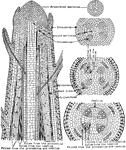
Plant Tissues
"Diagram showing the evolution of tissues from the primordial meristem down to the beginning of cambial…
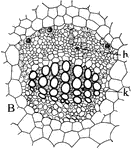
Collateral Vascular Bundle
Types of vascular bundles: "B, the collateral type, with phloem, h, standing in front of the xylem,…
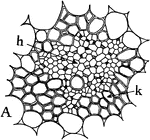
Concentric Vascular Bundle
Types of vascular bundles: "A, the concentric type, with xylem, k, surrounding the phloem, h." -Stevens,…

Radial Vascular Bundle
Types of vascular bundles: "C, a portion of the radial type, shown complete in D, where the part outlined…

Vascular Bundles
"Diagram showing how the vascular bundles anastomose around the medullary rays. The gaps represent the…
Plant Vein
"Diagram indicating the succession of the conducting tissues of a vein from the base toward the apex.…
Water Flow in Plants
"Diagram showing the relation of the water-carrying tissues of the leaves to those of the stem, and…

Leaf Water Flow
"Semi-diagrammatic cross section of a leaf showing by arrows how the water passes from the tracheal…

Leaf Water Flow
"Diagram to show the path of the water as it rises to, and escapes from, the leaves." -Stevens, 1916

Grapevine Wood
"Tangential section through the wood of grapevine. m, cells of medullary ray, and n, of xylem parenchyma,…
L. Tulipifera Wood
"Tangential section of wood of Liriodendron tulipifera, showing frequency of contact of medullary rays…
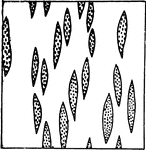
Oak Wood
"Outline of tangential section of wood of oak, to show frequency of medullary rays. The section is 1…
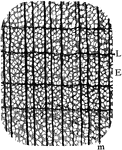
Yellow Poplar Wood
"Cross section of yellow poplar wood. E, early; L, late growth; m, medullary ray." -Stevens, 1916
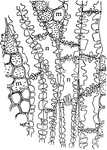
Yellow Poplar Wood
"Showing pitted connections between medullary rays and xylem parenchyma, and between contiguous xylem…
Xylem Development 1
"Stages in the development of the elements of the xylem. A, progressive steps in the development of…
Xylem Development 2
Stages in the development of the elements of the xylem. "B, stages in the formation of tracheids from…

Xylem Development 3
Stages in the development of the elements of the xylem. "C, steps in the development of wood fibers…
Xylem Development 4
Stages in the development of the elements of the xylem. "D, steps in the formation of wood parenchyma…
